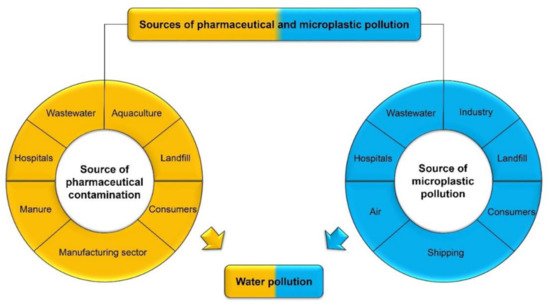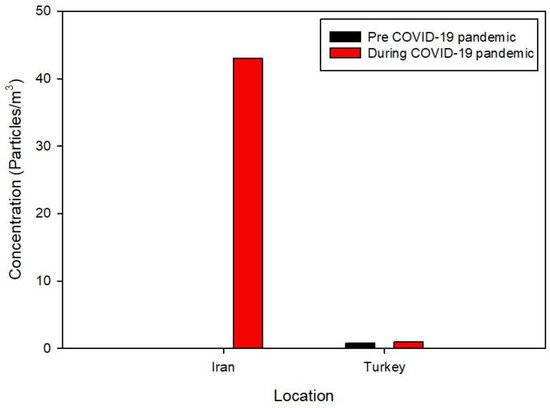Your browser does not fully support modern features. Please upgrade for a smoother experience.
Please note this is an old version of this entry, which may differ significantly from the current revision.
Subjects:
Environmental Sciences
|
Chemistry, Analytical
Pharmaceuticals (PhACs) and microplastics (MPs) are emerging pollutants that pose serious environmental risks. PhACs have been found in low concentrations in a variety of environmental samples, including sewage treatment plant effluents, surface water, seawater, and groundwater, in a number of countries.
- pharmaceuticals
- microplastics
- COVID-19
1. Introduction
The preservation of marine ecosystems has become a prominent environmental concern in the last 50 years [1], but particularly during the COVID-19 pandemic. The causes of water contamination can be classified as either natural or anthropogenic [2]; however, the effects of anthropogenic contamination on aquatic ecosystems are much more severe than those of natural contamination. Nevertheless, the impact of emerging pollutants resulting from the COVID-19 pandemic on the ecosystem is poorly understood [3,4]. Regarding the impact of lockdowns on river pollution, we must take into account the consumption of certain pharmaceuticals (PhACs) and personal care items for managing and preventing COVID-19 which spiked during the pandemic [5]. Additionally, the use of single-use plastics generated large volumes of waste, including hospital waste, post-used PPEs, confirmatory COVID-19 tests, and vaccination residues, as well as packaging in general [6]. PhACs and microplastics (MPs) are emerging pollutants that pose serious environmental risks [7,8,9]; thus, there is a challenge for scientists to identify approaches that will decrease the presence of pharmaceutical (PhAC) residues and microplastic (MP) particles in aquatic environments [10] given their hazardous impacts on aquatic ecosystems. However, their global release into aquatic ecosystems is far from understood. One of the primary reasons for this is that the MP and PhAC sources have been largely undocumented. Furthermore, it is difficult to determine the form of MP and PhAC in water. For example, MPs can be surface water pollutants, which are of concern, or they can be suspended in the water and be of less concern. However, the amount of MPs and PhACs in the water can be estimated using the volume of water that is polluted.
PhACs have been found in low concentrations in a variety of environmental samples, including sewage treatment plant effluents, surface water, seawater, and groundwater, in a number of countries [11,12]. Non-steroidal anti-inflammatory drugs, antibiotics, beta-blockers (-blockers), antiepileptic drugs, blood lipid-lowering agents, antidepressants, hormones, antihistamines, and X-ray contrast media are among the PhACs that are environmentally hazardous [13,14]. The consumption of PhACs increased during the COVID-19 pandemic, and a high volume of PhAC residues were released into the wastewater as well as to the sea and rivers because of hospital discharges and PhAC factories. It has been reported that the concentration of most of the PhACs used in the treatment of COVID-19 increased during the pandemic in water bodies [15]. Additionally, the PhACs from households, such as pills, capsules, and tablets, are released into wastewater. Through the wastewater, PhACs are released into natural ecosystems, such as rivers, lakes, and oceans. The PhACs from wastewater reach the environment after several transformations, from wastewater through hydrological pathways.
Plastic materials have many superior features compared to traditional materials due to their durability, malleability, low cost, versatility, and impermeability; nonetheless, their persistence in the environment has led to environmental concerns [16,17]. Plastic particles are categorized into three distinct size categories: (1) mesoplastics (500 μm–5 mm), (2) microplastics (MPs; 50–500 μm), and (3) nanoplastics (<50 μm) [10,18]. MPs are plastics with a primary diameter of less than 0.5 mm [19,20] that can be primary particulates or secondary fragments formed by weathering or degradation of primary plastics [20] and MP contamination is widespread due to the widespread use of plastics in society and industry, as well as the persistence and easy transport of sub-mm-sized primary and secondary particles [21,22,23]. The largest accumulation of plastic occurs in the ocean, which is estimated to have more than 500 million tons of plastic generally sourced from land-based emissions. These plastics have been accumulating in the ocean for decades, but the scale of plastic pollution in the ocean has only been realized in the last decade with the advent of oceanographic techniques to detect plastic, such as net tows and trawls. An estimated 80% of the world’s population lives within 100 km of the ocean, making the ocean an important source of plastic pollution for humans, wildlife, and ecosystems. For this reason, the majority of the international scientific community’s focus has thus far been on the research of plastic pollution in oceans [10]; however, the lack of information on the effects of plastic pollution on inland ecosystems is a major cause for concern [24].



2. Distribution of Pharmaceutical Contamination in the Aquatic Environments
In recent years, PhACs and MPs have been identified in many aquatic habitats. Several types of PhACs have been detected in aquatic environments [25,26,27,28,29,30,31,32,33,34,35,36,37,38,39,40,41,42,43,44,45,46,47,48,49,50,51,52,53,54,55,56,57]. The most common PhACs were antibiotics (included penicillin, aminoglycoside, tetracycline, and erythromycin), cardiovascular drugs (including calcium channel blockers, angiotensin-converting enzyme inhibitors, and beta blockers), and psychiatric drugs (including antipsychotics, antidepressants, anxiolytics, and hypnotics). Consumption of antibiotics increased during the COVID-19 pandemic, and this has been a significant influence on the release of PhACs from wastewater of hospitals to aquatic environments over the last two years.
In aquatic environments, pH, temperature, time, enzymes, ionic strength, and water depth all play crucial roles in the adsorption, degradation, and transport of PhACs [10]. For instance, ionic strength and pH can influence the adsorption and transport of two antibiotics, sulfamethoxazole and ciprofloxacin [10,58]. Water content, pH, and temperature also have an effect on the decomposition of PhACs such as aspirin [10,59]. Degradation of PhACs in the summer is higher than in winter, which has an effect on the increasing spread of PhACs in aquatic environments [10]; this is because most of the PhACs transfer to surface water, and some of them go to deeper layers of water.
The key sources of PhACs and their metabolites in the environment are the following: (1) the PhACs manufacturing sector, which includes industrial wastewater discharge and solid wastes containing PhACs, as well as stormwater runoff transporting powdered drugs [10,60]; (2) consumers/households, including PhACs excretion and inappropriate discharge to wastewater systems [10]; (3) hospitals, including the discharge of wastewater and solid wastes; and (4) agriculture and aquaculture including the using of hormones and other PhACs for poultry, livestock, shrimp, and fish [10] (Figure 1). Indeed, about half of the PhACs are excreted by humans and animals are released into the environment. One or more of these sources can be relevant to each case in our research. For instance, in India, the high density of the population corresponds with the high rate of consumption of PhACs. In Nigeria, high concentrations of PhACs were related to high consumption and the old technology used in WWTPs. Moreover, the COVID-19 pandemic has been the main reason for the increased global consumption of PhACs.

Figure 1. Sources of PhAC and MP pollution in aquatic environments.
3. Distribution of Microplastic Pollution in the Aquatic Environments
Polyethylene, polypropylene, polyethylene terephthalate, polyvinylchloride, polyester, and polystyrene are all common polymers found in aquatic environments [73,74,75,76,77,78,79,80,81,82,83,84,85,86,87,88,89,90]. These materials are primarily used for packaging, plastic bottles, and other products. They are also used for food packaging and containers. The primary concern with these materials is their impact on the aquatic environments. They are non-biodegradable, so they accumulate in the environment and have the potential to harm aquatic organisms.
The effects of MPs on the environment are mainly related to their size, shape, charge, surface coating, agglomeration rate, density, and other properties [10,91]. The results focused on the most important factors of MPs in aquatic environments, namely size, shape, color, concentration, and kind of polymer. To compare the impact of MPs in surface water before and after the COVID-19 pandemic, it is useful to look at data from Turkey (Figure 5). Here, it was found that the concentration of MPs from 2009 to 2020 increased by more than threefold in the waters of the Black Sea [84]. Indeed, in 2009 the concentration of MPs was at its lowest level (0.331 Particles/m3). Meanwhile, in the Black Sea from 2010 to 2020 the concentration of MPs increased. The highest concentration of particles (0.944 Particles/m3) was observed in 2020 [84]. In the surface water of Iran, the concentration of MPs increased during the COVID-19 pandemic (43 Particles/m3 in 2021) by comparison with that before the pandemic (0.000061 Particles/m3 in 2019) [79,92]. This was due to the fact that the COVID-19 pandemic led to an increase in the use of masks, gloves, and other disposable plastic.

Figure 5. Concentrations of MP pollution in pre-COVID-19 period and during COVID-19 period in surface water.
4. Pharmaceutical and Microplastic Pollution before and during the COVID-19 Pandemic
4.1. Concentrations of Pharmaceutical Contamination before and during the COVID-19 Pandemic
Concentrations of PhAC contamination during the COVID-19 pandemic have increased in comparison with before the pandemic in aquatic environments (Figure 6). For instance, the concentration of diclofenac in Ghana’s surface water in 2019 was 30 ng/L, but in 2021 during the COVID-19 pandemic, the concentration increased to 100.91 ng/L [52,55]. On the other hand, 90 ng/L of ketoprofen were found in the influent of water in Italy in 2013; however, the ketoprofen rate in 2020 was 5.84 ng/L which shows a remarkable decrease [43,66]. In China surface water data before and during the pandemic showed differences. Indeed, the number of PhACs before the pandemic was higher than that during the pandemic, but the PhACs concentrations before the pandemic were lower than during the pandemic. The concentrations of tetracycline (5.27 ng/L in 2019 and 1.52 ng/L in 2020), sulfamerazine (0.79 ng/L in 2019 and 0.06 ng/L in 2020), doxycycline (9.44 ng/L in 2019 and 0 in 2020), ciprofloxacin (14.0 ng/L in 2019 and 0 in 2020), and ofloxacin (2.12 ng/L in 2019 and 0 in 2020) before the pandemic were higher than during the pandemic. Conversely, the concentration of azithromycin in 2020 was 0.16, which was higher than 0 in 2019 [67]. Meanwhile, the concentrations of fluoxetine in influent and effluent before the pandemic were 2.6 ng/L and 1.4 ng/L, and during the pandemic, they were 4.25 ng/L and 1.05 ng/L, respectively [65,99]. Additionally, in groundwater in China, results in 2019 and 2020 showed differences before and during the pandemic. The concentration of tetracycline (2.63 ng/L in 2019 and 2.11 ng/L in 2020), doxycycline (5.73 ng/L in 2019 and 4.35 ng/L in 2020), ciprofloxacin (14.83 ng/L in 2019 and 1.84 ng/L in 2020), and ofloxacin (7.56 ng/L in 2019 and 3.06 ng/L in 2020) before the pandemic were higher than during the pandemic. Conversely, the concentration of sulfamethazine and azithromycin in 2020 were 0.02 ng/L and 0.10 ng/L, which shows a gain in comparison with 2019 [67].

Figure 6. Concentrations of PhAC contamination in pre-COVID-19 period and during COVID-19 period.
4.2. Concentrations of MP Pollution before and during the COVID-19 Pandemic
Concentrations of MP pollution before and during the COVID-19 pandemic show that the quantity of MPs increased during the pandemic compared with the pre-COVID-19 period in surface water (Figure 5). For example, the concentration of MPs in the surface water in Turkey and Iran during the COVID-19 pandemic was higher than that pre-COVID-19 period. The concentration of MPs in Iran’s surface water in 2016 was 0.000042 Particles/m3, in 2019, 0.000061 Particles/m3, but in 2021, during the COVID-19 pandemic, this rate increased to 0.246 Particles/m3 [79,100]. Moreover, [92] detected 43 Particles/m3 of MPs in Iran’s surface water. In fact, the concentration of MPs in the surface water of Iran is increasing due to the presence of different types of plastics. Additionally, 0.750 Particles/m3 of MPs were found in the surface water of Turkey in 2019; however, the MPs concentration in 2020 was 0.944 Particles/m3 which shows an increase [84] (Figure 5).
This entry is adapted from the peer-reviewed paper 10.3390/w14193082
This entry is offline, you can click here to edit this entry!
